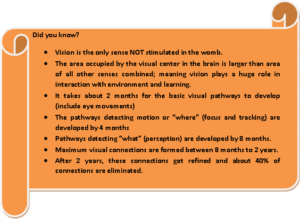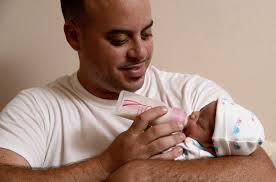VISION: THE ART OF SEEING

Vision is constantly relied on to get information from the environment. Learning about our surroundings like colors, shapes, objects, people and their respective significance daily life is primarily based on vision in the first 2 years of life. It is also used as an ingredient for complex interactions like eye-hand coordination, eye-foot coordination, depth and distance perception and anticipatory protective responses, especially during sports.

During the first year, visual recognition of objects helps to build up visual-perceptual skills. These skills are essential in academics and daily skills like driving or organizing your home.
These are:
- Form consistency: Ability to recognize the same shape in any context. This helps with learning colors, shapes, numbers and alphabets.
- Discrimination: Ability to identify differences in a group of objects. This skill is useful for knowing the difference between zero and ‘o’ or finding matching socks in the drawer.
- Figure-ground perception: Ability to differentiate between foreground and background. Extremely important for stairs and threshold that are not well demarcated.
- Visual memory: Ability to remember what you have seen. This is used in our daily life to recognize directions based on neighborhood landmarks, people we have met a while ago or even where you’ve last put your keys!
- Visual sequencing: Ability to put a sequence based on visual cues. This is how reading sight words and spelling are learned.
- Visual closure: Ability to complete the rest of the picture based of a partial visual cue. Helps in speed reading as you fill in words by looking at some important ones only.
- Visual-Spatial relation: Ability to understand position of the object in relation to the environment. Useful in following directions like “bring the socks from the second drawer on the left” or “your shoes are under the red chair.”
Given the tremendous reliance on vision, let’s look at some strategies to help vision along.
0-3 months: 
- Holding the baby close to rock, sing and cuddle are prefect times for the baby eyes to learn how to focus on your face and recognize facial features
- Since contrasting colors grab more attention in early months, mobile toys with black and white or red colors are useful.
- Allowing hand to mouth exploration is also part of the large eye-hand coordination process as this exploration leads to hand awareness and builds coordination in the arms.
3-6 months:

- This is the peak time for eye-hand coordination development. Providing hanging toys like crib mobiles or on play mats is a good option to strengthen this skill.
- Babies are also tracking and following people and objects in their vicinity. Tracking skills are building blocks for object permanence.
- Mirrors can be used gradually around this time though cognitively recognizing a reflection comes a little later.
6-9 months:
- Allowing play with objects of daily use and associating them with pictures in books is a good way to start building up visual memory.
- Action songs so baby can imitate your hand/body movements.
- Creeping and crawling to stimulate depth perception
9-12 months:

- Games like pee-a-boo, rolling ball and finding hidden toys are great ways for visual scanning of the environment.
- Naming and pointing objects
- Doing obstacle courses, crawling up and down stairs are great ways to develop visuo-perceptual skills.
12- 18 months:
- Ball games- rolling, catch, throw, kick.
- Shape sorters, building blocks, simple one piece puzzles.
- Sequencing stories from books or daily life.
18-24 months:

- Games that incorporate eye-hand, eye-foot coordination like soccer, cricket.
- Involving child in their daily routines like finding their own pair of socks or getting their spoons out of the drawer will improve their visual- perceptual skills.
- With sufficient independence in fine motor skills, some simple crafts and coloring great ways to improve visual-perception.
Our eyes are the most used sensory organ and we rely on our vision not just for interaction with the environment but also at times to trust our instincts. We are very quick to believe in something visible! But seeing is just the starting point of believing, right?
“The only thing worse than being blind is having sight but no vision.” – Helen Keller.
Puja
19/1/2015
